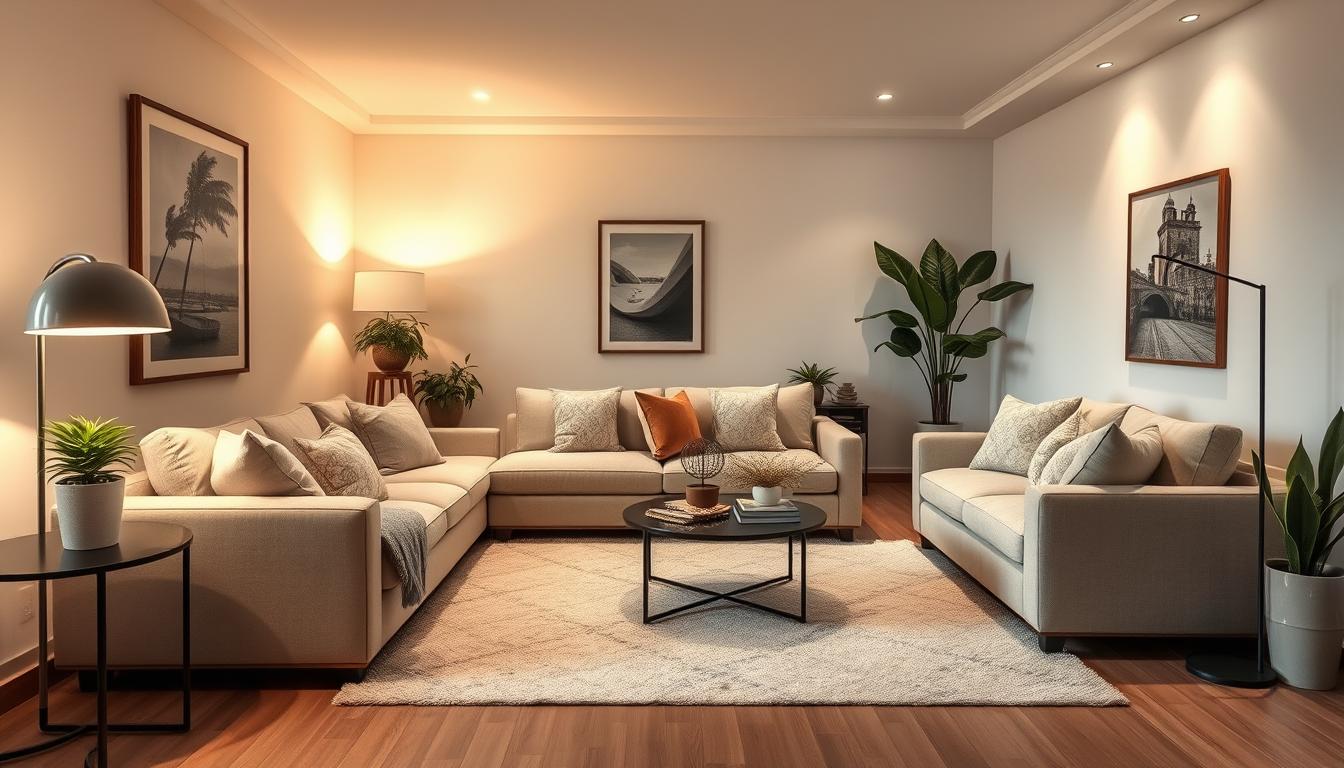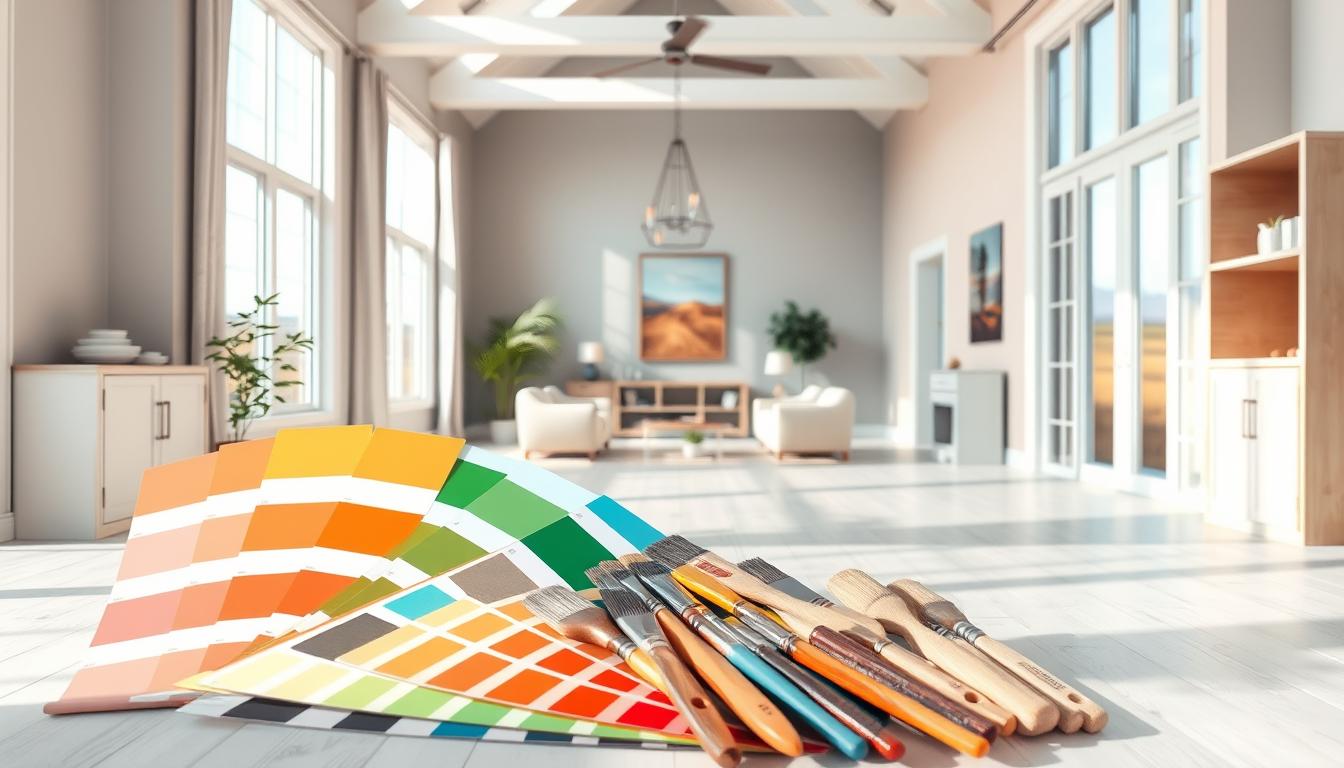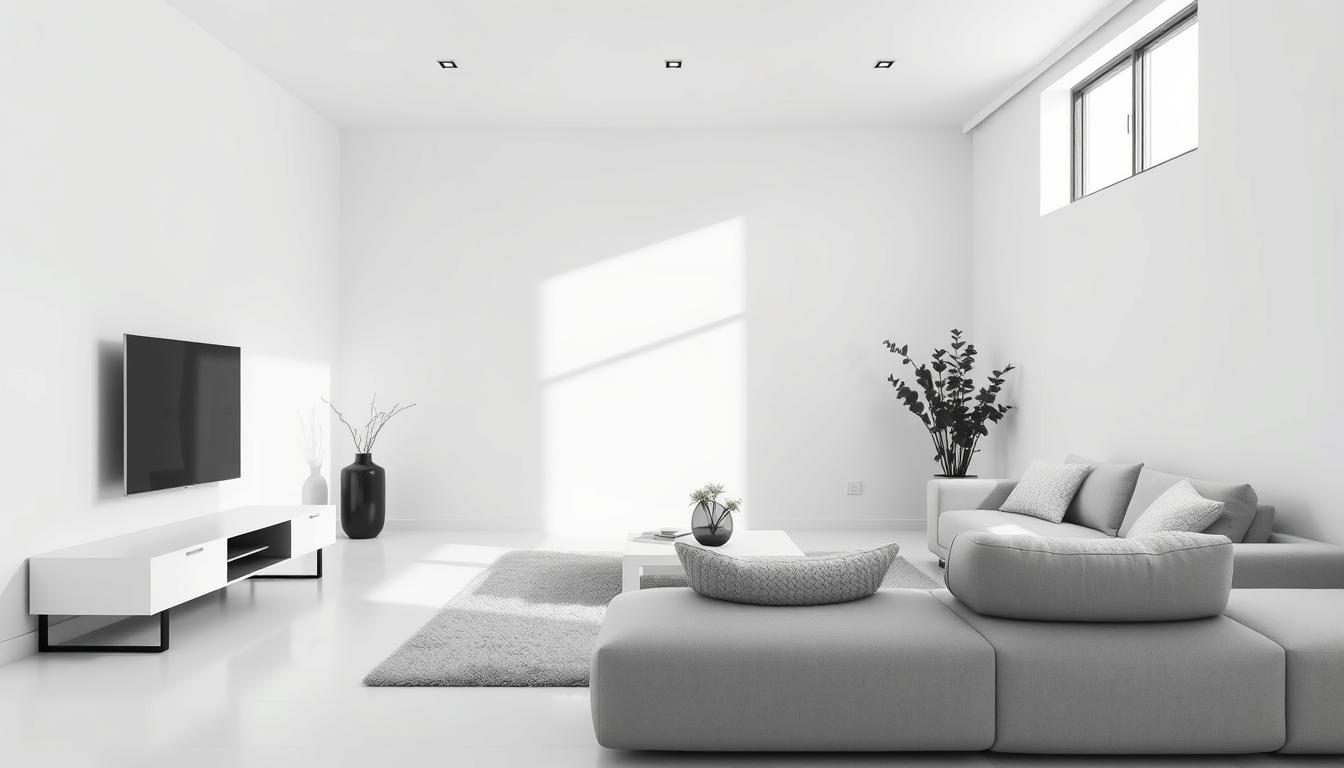Did you know a well-designed living space can make you happier and more productive? Making your living space stylish and welcoming is simpler than you might think.
We’ll share our best interior decorating ideas to help you create a beautiful and useful space.
We’ll show you how to pick a color scheme, mix textures and patterns. We’ll guide you in making a space that shows off your personality.
Key Takeaways
- Start with a plan to achieve a cohesive look
- Choose a color scheme that sets the tone for your space
- Mix textures and patterns to add depth and visual interest
- Consider the functionality of your space
- Add decorative elements to reflect your personality
Understanding the Basics of Home Interior Design
A well-designed home interior starts with knowing the basics. Home interior design blends beauty with function. It makes living spaces both stunning and practical.
What is Home Interior Design?
Home interior design is about making homes look and feel better. It’s about understanding what homeowners want. Then, it turns those wishes into spaces that are both beautiful and useful.
There are many styles to choose from, like Scandinavian, Japandi, and Boho. Each style has its own look, like Scandinavian’s simplicity or Boho’s mix of patterns.
- Scandinavian design focuses on simplicity and function.
- Japandi style mixes Japanese and Scandinavian, valuing minimalism and natural materials.
- Boho style is all about eclectic and vibrant decor, blending patterns and textures.
Key Principles of Interior Design
Knowing the key principles of interior design is key to a harmonious space. These include balance, proportion, emphasis, movement, pattern, unity, and contrast.
- Balance is about the visual weight in a room, achieved through symmetry or asymmetry.
- Proportion is about furniture and decor sizes in relation to the room and each other.
- Emphasis is about creating a focal point to catch the eye.
By using these principles, homeowners can make spaces that look good and feel great. Whether you’re searching for room decor inspiration or modern home design tips, knowing these basics is the first step to achieving your design dreams.
Choosing the Right Color Palette for Your Space
Choosing the right color palette is key to a stylish interior design. The colors you pick can greatly change how your home feels. They can make your space feel calm or lively.
Impact of Colors on Mood
Colors deeply affect our feelings and mood. Cool colors like blue and green can make us feel calm. Warm colors like red and orange can make us feel more energetic. Interior design experts say it’s important to know how colors make us feel.
“Color is a power which directly influences the soul. Color is the keyboard, the eyes are the hammers, the soul is the piano with many strings. The artist is the hand that plays, touching one key or another, to cause vibrations in the soul.”
Think about what each room is for. Bedrooms should have calming colors for rest. Home offices might do better with colors that energize.
Tips for Selecting a Color Scheme
Choosing a color scheme can be tough, but here are some tips:
- Consider the natural light in your space. Rooms with lots of natural light can handle bold colors. Darker rooms might need lighter shades.
- Think about the style and era of your furniture and decor. Some colors go better with certain styles than others.
- Use the 60-30-10 rule: 60% of a dominant color, 30% of a secondary color, and 10% of an accent color. This can create a balanced and harmonious palette.
| Color | Mood/Atmosphere | Best Used In |
|---|---|---|
| Blue | Calming, Serene | Bedrooms, Bathrooms |
| Red | Energizing, Stimulating | Living Rooms, Dining Rooms |
| Green | Balancing, Refreshing | Home Offices, Living Rooms |
By thinking about these factors and tips, you can pick a color palette that shows your style. It will also make your home look and feel better.
For more home renovation tips and to see different stylish interior design ideas, keep an eye out for our next articles. We’re here to help you make your dream home a reality.
Selecting Effective Furniture for Your Interiors
Finding the right furniture is key to contemporary home interiors. The right pieces can make your space look great. The wrong ones can make it look bad. It’s all about finding furniture that looks good and works well.
Importance of Scale and Proportion
Choosing furniture that fits your space is crucial. Scale and proportion are important for a nice look. A big piece can make a small room feel cramped. A small piece can get lost in a big room.
- Measure your space carefully before selecting furniture.
- Consider the scale of furniture in relation to the room’s dimensions.
- Balance large pieces with smaller ones to create visual harmony.
Multi-Functional Furniture Options
In today’s homes, space is often limited. That’s where multi-functional furniture helps. These pieces do more than one thing, saving space without losing style.
- Sofa beds that convert from seating to sleeping areas.
- Storage ottomans that provide a place to sit and store items.
- Nesting tables that can be used as needed and stored away when not in use.
For more tips on arranging furniture effectively, check out our guide on mastering furniture arrangement for optimal space.
By focusing on scale, proportion, and multi-functionality, you can create a beautiful living space that is both stylish and functional. Remember, the key to successful furniture selection is understanding your space and your needs.
Creating a Functional Layout
A well-planned layout is key to any interior design project. It boosts the look of your space and makes it more useful. When designing your home, think about how people move around. This helps make your space feel welcoming and comfortable.
Flow and Movement in Design
The way furniture is set up affects room flow and movement. A good layout makes moving around easy and feels harmonious. Think about pathways and circulation in your home. Make sure there’s enough room between furniture for easy movement.
Using apartment design trends for open spaces can also help. For example, multi-functional furniture keeps things tidy. This makes moving around smoother.
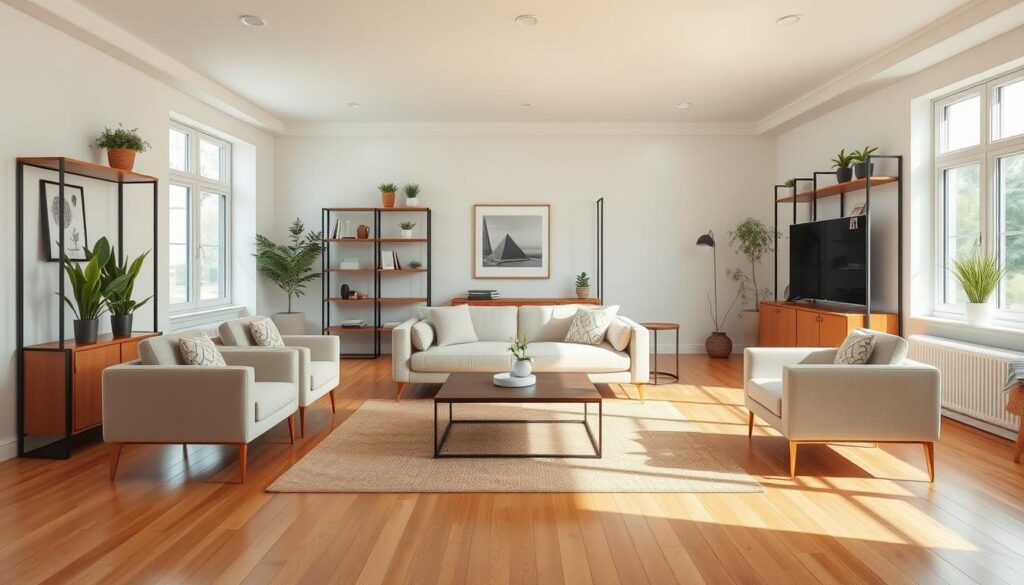
Common Layout Mistakes to Avoid
When setting up a layout, watch out for common mistakes. One big error is poor circulation paths, making rooms feel tight. To avoid this, arrange furniture to keep paths clear.
- Placing too much furniture in a small space, which can obstruct movement.
- Ignoring the scale and proportion of furniture in relation to the room size.
- Not considering the purpose of the room and how it will be used.
By avoiding these mistakes and using interior decorating ideas for flow and function, you can make a space that looks great and works well.
Incorporating Lighting into Your Design
Lighting is more than just turning on a switch. It’s key to making your home feel warm and welcoming. When designing, think about how lighting can improve both looks and function.
Types of Lighting Fixtures
There are many lighting fixtures to choose from. Each one can change the feel of a room in its own way. Here are a few:
- Ambient Lighting: This lighting covers the whole room, letting you see and move around.
- Task Lighting: It shines on areas where you do things like read or cook.
- Accent Lighting: It highlights special features or objects in the room.
Tips for Layering Light
Layering light makes a space look good and work well. Here’s how to do it:
- Begin with ambient lighting to light up the whole room.
- Add task lighting where you need it for activities.
- Accent lighting brings out special features or decorations.
- Dimmers help change the light levels for different times and activities.
Using these lighting layers, we can make a stylish and useful space. It meets our needs and boosts our modern home design.
Textures and Patterns: Adding Depth
Textures and patterns make a space look good and interesting. They add depth and character to your home. This makes it more welcoming and fun.
Mixing Textures for Visual Interest
Mixing different textures makes a room more interesting. You can pair smooth surfaces with rough ones. Or soft fabrics with rugged materials.
For example, a sleek leather sofa with a chunky woven rug looks great together. It adds depth to the room.
To mix textures well, know the 5 main types: natural, synthetic, metallic, visual, and tactile. Using many textures makes your space rich and inviting.
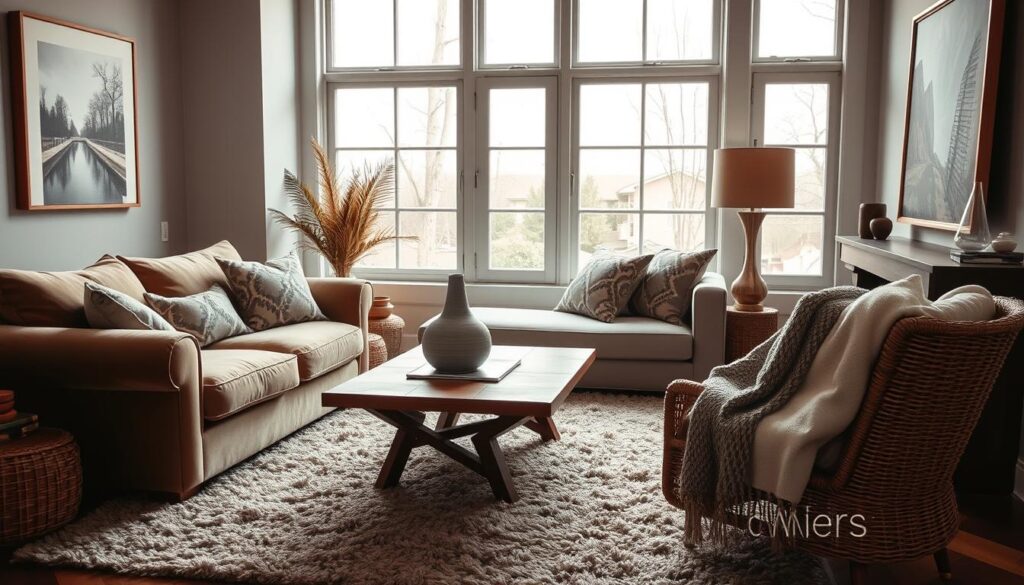
Using Patterns to Enhance Your Space
Patterns also make your home decor better. They can be geometric shapes or floral motifs. They add interest and personality to a room.
When picking patterns, think about the look you want. Choose patterns that match your decor.
To not overwhelm the space, balance patterns with solid colors. Use 2-3 main patterns and solid colors to fill in. This makes your space look good and shows your style.
By using textures and patterns wisely, you can make your home stylish and welcoming. Whether it’s one room or your whole house, these elements help create a beautiful space.
Personalizing Your Home with Decor
Making your house a home is more than just furniture. It’s about adding decor that tells your story. Personalizing your space with decor makes it inviting and reflects your style.
Importance of Personal Touches
Personal touches can greatly change your home’s feel. According to House Beautiful, adding personal items warms and makes your home feel like home. As interior decorating ideas change, personalization is key to beautiful living spaces.
“The most personal things in our homes are often the most meaningful,” design experts say. This shows how important it is to display personal items in your decor.
Creative Ways to Showcase Personal Items
There are many ways to show off personal items in your home. Here are a few ideas:
- Use shelves or mantels to display personal collections or heirlooms.
- Create a gallery wall featuring family photos or artwork.
- Incorporate personal items into your decor, such as vintage furniture or antique pieces.
By using these interior decorating ideas, you can make a space that’s truly yours. Remember, it’s the personal touches that turn a house into a home.
As we keep exploring ways to make our homes more personal, remember personalization is a journey. It’s about creating a space that grows with you and shows your changing tastes and experiences.
Utilizing Space Planning Techniques
To make your living space both harmonious and functional, using space planning techniques is key. This involves arranging your home’s layout to boost its looks and usefulness.
Open vs. Closed Floor Plans
Choosing between an open or closed floor plan is a big decision in space planning. Open floor plans are popular for making spaces feel bigger and helping people connect. Yet, closed floor plans provide privacy and are great for homes where everyone needs their own space.
- Pros of Open Floor Plans:
- Enhances the sense of space
- Facilitates social interaction
- Improves natural light distribution
- Cons of Open Floor Plans:
- Lack of privacy
- Noise can travel easily
Planning for Specific Activities
Designing spaces for specific activities is also crucial in space planning. For example, a dedicated home office can boost productivity, while a well-designed kitchen makes cooking easier.
- Identify the primary activities that will take place in each room.
- Consider the flow of movement between different areas.
- Use furniture and decor to define different zones within a room.
By using these techniques, you can make your home both beautiful and practical. It will show off the latest apartment design trends and include useful home renovation tips.
Sustainability in Home Design
In today’s world, making our homes eco-friendly is essential. Our homes are key in reducing our environmental impact. Modern home design now focuses on looks and green living.
Benefits of Eco-Friendly Materials
Using eco-friendly materials in our homes is beneficial. They are sourced sustainably, saving natural resources. They also cut down on greenhouse gas emissions. Plus, they help keep our air clean, making our homes healthier.
Some key benefits of eco-friendly materials are:
- Less harm to the environment
- Better air quality inside
- Sustainable sourcing
- Lower carbon footprint
How to Incorporate Sustainable Practices
We can make our homes more sustainable in several ways. First, choose materials that are recycled or sustainably sourced. We can also use energy-saving appliances and lights to cut down on energy use and bills.
Here are some tips for making our homes greener:
- Use energy-efficient lights and appliances
- Go for sustainable materials for furniture and decor
- Set up recycling and composting systems
- Think about using solar panels for energy
By following these tips, we help the planet and make our homes stylish. Our homes show how style and sustainability can go hand in hand. As we find new ways to live sustainably, our homes become symbols of both beauty and eco-friendliness.
Staying Up-to-Date with Design Trends
Home decor is always changing. It’s key to know the latest trends. Interior design trends change due to tech, green living, and cultural shifts.
Current Trends in Interior Design
Now, we’re moving towards greener home designs. Eco-friendly stuff, energy-saving gadgets, and living green are big. Smart home tech is also popular for making life easier.
Some top trends include:
- Using natural materials and textures
- Adding plants for better air
- Going for bold colors and big pieces
- Choosing simple, minimalist designs
How to Incorporate Trends Without Overcommitting
It’s fun to follow trends, but don’t change your whole home every season. Here are some tips:
| Trend | Incorporation Tip |
|---|---|
| Sustainable Materials | Start by replacing one item, like a throw blanket, with a sustainable alternative. |
| Smart Home Technology | Begin with one device, such as a smart thermostat, and gradually add more. |
| Bold Colors | Use bold colors in accent pieces like pillows or a statement wall. |
By adding trends wisely, we can keep our homes looking modern. We don’t have to spend a lot or redo everything every year.
Designing for Different Lifestyles
Creating a beautiful living space is key. Home interior design includes colors and furniture. It’s vital to think about the needs of those who will use it.
Family-Friendly Design Considerations
For families, a good design is both useful and fun. We can use durable materials and make zones for activities. It’s also important to make sure the space is safe and easy to get around.
Designing for Remote Work and Home Offices
Remote work has made home offices crucial. We need to think about lighting, ergonomics, and noise. This helps us stay productive and focused.
By focusing on different lifestyles, we can make spaces that are both useful and beautiful. Good home design improves our lives. It’s important to get it right.

